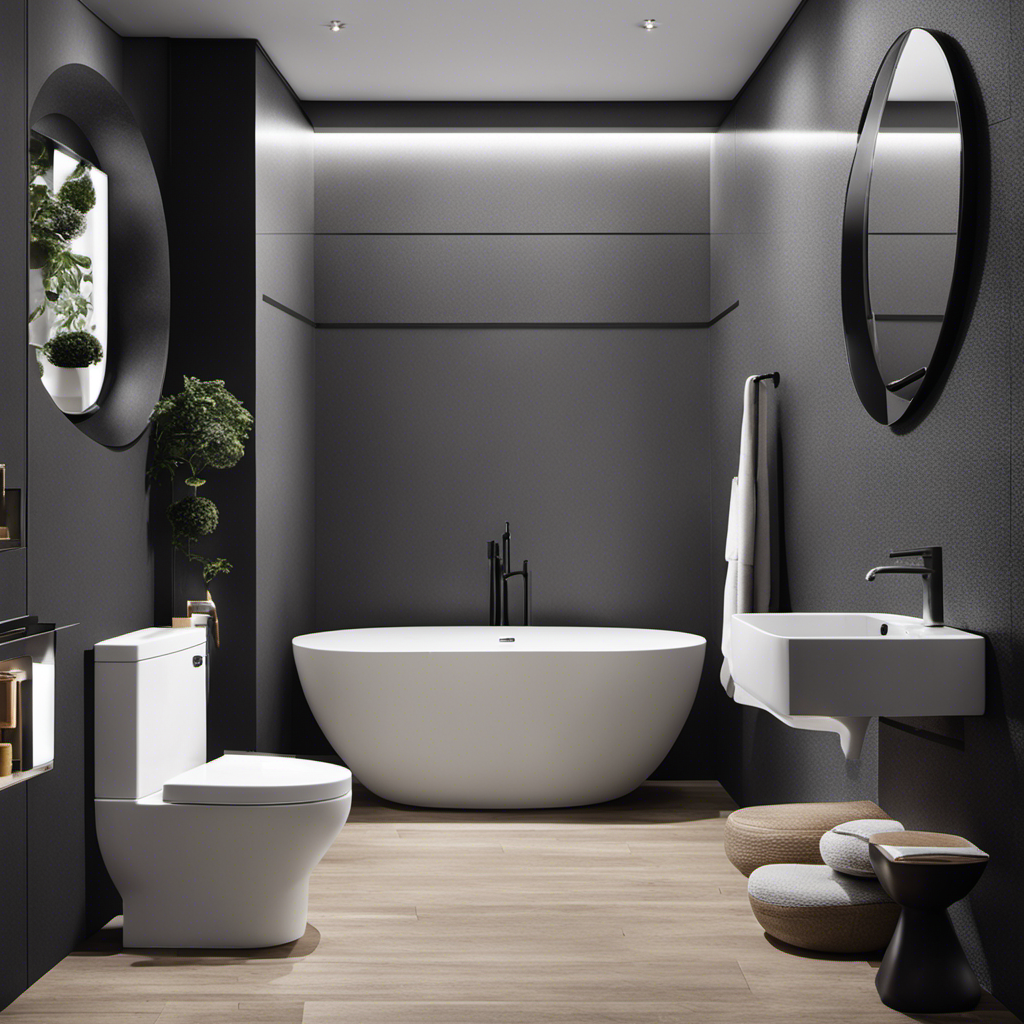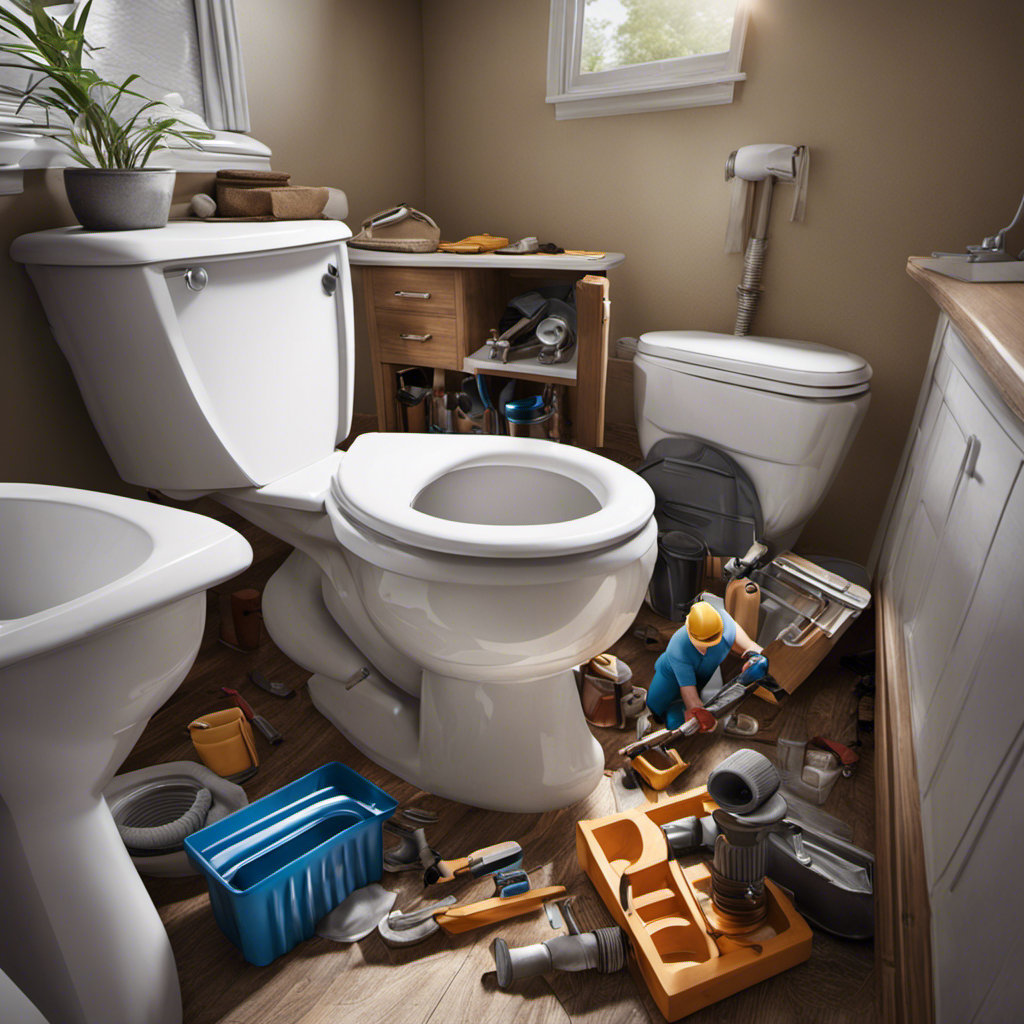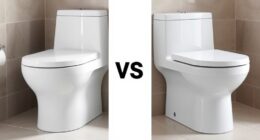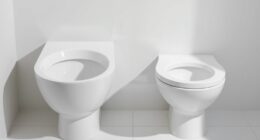As I dive into the world of toilets, I find myself pondering the weighty matter of toilet weights.
In this comprehensive guide, I will explore the various aspects of toilet types, brands, and materials, shedding light on the factors that contribute to their weight.
From the sturdy one-piece toilets weighing around 100 pounds to the lighter two-piece options at approximately 50 pounds, we will uncover the secrets behind different toilet weights.
So, let’s flush out the details and dive into the fascinating world of toilet weights.
Key Takeaways
- Toilet weights can vary depending on the type, with one-piece toilets weighing around 100 pounds and two-piece toilets weighing roughly 50 pounds (bowl or tank).
- Different brands and models of toilets can have varying weights, with examples like the American Standard Champion 4 weighing 119 lbs and the TOTO Ultramax II weighing 99 lbs.
- Porcelain, particularly vitreous china, is the primary material used in toilet manufacturing due to its strength, durability, and long-lasting properties.
- The size, design, and installation method of toilets can also affect their weight, with factors such as comfort height, compactness, and tank size influencing the overall weight.
The Weight Difference: One-Piece Vs. Two-Piece Toilets
I prefer two-piece toilets because they are lighter and easier to lift and install compared to one-piece toilets.
Two-piece toilets have a separate bowl and tank, which makes them significantly lighter, weighing approximately 50 pounds for either the bowl or the tank. This weight advantage offers several benefits.
Firstly, it makes transportation and installation much simpler, especially in situations where maneuvering heavy objects is challenging. Secondly, the lighter weight reduces the risk of injury during the installation process.
However, there are also disadvantages to consider. Two-piece toilets have more crevices and joints compared to one-piece toilets, which can potentially lead to increased maintenance and cleaning efforts. Additionally, the additional parts of a two-piece toilet may require more frequent replacement compared to a one-piece toilet.
Despite these disadvantages, the advantages of lighter weight and ease of installation make two-piece toilets a popular choice for many homeowners.
Exploring Brand and Model Variations in Toilet Weights
The weight of different toilets can vary depending on the brand and model. When comparing weight variations among popular toilet brands, it is important to consider how toilet weight impacts installation and transportation.
Brand and model variations play a significant role in determining the weight of a toilet. For example, the American Standard Champion 4 one-piece toilet weighs 119 lbs, while the TOTO Ultramax II one-piece weighs 99 lbs. These differences in weight can affect the ease of installation and transportation.
Heavier toilets may require more effort and assistance during installation, while lighter toilets are generally easier to handle. Additionally, transporting heavier toilets can be more challenging and may require specialized equipment.
Therefore, understanding the weight variations among popular toilet brands is crucial when considering installation and transportation logistics.
The Role of Material and Manufacturing in Toilet Weight
Porcelain toilets, commonly used in manufacturing, are known for their strength and durability. The material used in toilet manufacturing has a significant impact on the weight of the toilet.
Porcelain, specifically vitreous china, is a popular material for high-quality toilets. It is strong, durable, and long-lasting. Leading brands utilize porcelain in their manufacturing processes to ensure the toilet’s durability.
Porcelain toilets are made using clay, which is molded and fired at high temperatures to create a solid and sturdy structure. The manufacturing processes also play a role in determining the weight of the toilet.
The design and size of the toilet, as well as the installation method, can affect its weight. Additionally, the inclusion of advanced features in smart toilets, such as bidets and heated seats, adds extra weight to the unit.
Overall, the choice of materials and the manufacturing processes employed significantly influence the weight of a toilet.
Size, Design, and Installation: Factors Affecting Toilet Weight
When considering toilet weight, factors such as size, design, and installation method all play a role in determining the overall weight distribution of a toilet. The size of a toilet can greatly impact its weight, with larger toilets generally weighing more than smaller ones. The design of a toilet, including features such as comfort height or wall-hung toilets, can also affect its weight. Additionally, the installation method can influence the weight distribution of a toilet, with certain methods requiring more support and therefore adding more weight to the overall unit. To better understand the factors influencing toilet weight distribution, refer to the table below:
| Factors | Influence on Toilet Weight Distribution |
|---|---|
| Size | Larger toilets tend to be heavier |
| Design | Features like comfort height add weight |
| Installation Method | Certain methods require more support and add weight |
Smart Toilets and Advanced Features: How They Impact Weight
I find that smart toilets with advanced features tend to be heavier due to the technology incorporated into them. The weight distribution in toilets is affected by the additional components added to smart toilet technology.
These toilets often include features such as bidets, heated seats, water sprays, and odor sprays, which contribute to their increased weight. For example, the Kohler Veil intelligent toilet weighs 110 lbs, while the TOTO 700H weighs 123 lbs. The added technology and functionality make these smart toilets heavier than traditional models.
It is important to consider this weight when installing a smart toilet, as it may require additional support or reinforcement. Despite their weight, smart toilets offer additional features and convenience, making them a popular choice for those seeking a high-tech bathroom experience.
The Pros and Cons of Heavy and Light Toilet Options
Installing a heavy toilet may require additional reinforcement, but it can provide stability and durability in the long run. When considering the installation of a heavy toilet, it is important to take into account the weight distribution and stability of the bathroom floor.
The added weight of a heavy toilet can put stress on the floor, especially if it is not properly supported. This can lead to cracks or even structural damage over time. Additionally, the installation of a heavy toilet may require additional support, such as floor joists or subfloor reinforcement, which can increase the overall installation costs.
It is essential to consult with a professional plumber or contractor to ensure that the necessary measures are taken to support the weight of a heavy toilet properly.
Choosing the Right Toilet Weight: Factors to Consider
Considering the weight of a toilet is important when choosing the right one for your bathroom. There are several factors to consider when determining the ideal toilet weight.
One of the main factors is the impact of advanced features on toilet weight. Smart toilets, for example, may be compact but are still heavy due to their advanced features such as bidets, heated seats, water sprays, and odor sprays. The technology in these smart toilets adds weight to the unit.
Additionally, the size, design, and installation of the toilet can also affect its weight. Comfort height toilets, which are taller and heavier than standard height toilets, and wall-hung toilets, which are light but complicated to install, are examples of how different designs and installation methods can impact toilet weight.
Frequently Asked Questions
Are There Any Toilets Made of Materials Other Than Porcelain?
Yes, there are toilets made of materials other than porcelain. Non-porcelain toilets, such as those made of stainless steel or plastic, offer advantages like durability and ease of cleaning, but may lack the aesthetic appeal of porcelain.
Can the Weight of a Toilet Affect Its Water Consumption or Flushing Power?
The weight of a toilet can affect its water consumption and flushing power. Heavier toilets may require more water to flush effectively, leading to increased water usage. Choosing a lighter toilet can help improve water efficiency.
Do Heavier Toilets Require Special Installation or Reinforcement in the Bathroom?
Heavier toilets may require special installation or reinforcement in the bathroom. The weight of a toilet can affect its water consumption and flushing power. It is important to consider these factors when choosing and installing a toilet.
Are There Any Lightweight Toilets That Still Offer Advanced Features Like Bidets or Heated Seats?
Yes, there are lightweight toilets available that offer advanced features like bidets and heated seats. These toilets are constructed using durable materials, such as porcelain and vitreous china, ensuring their longevity and functionality.
How Does the Weight of a Toilet Impact Its Durability and Lifespan?
The weight of a toilet can impact its durability and lifespan. A heavier toilet may be more durable and less likely to require plumbing maintenance. However, it can also have a higher environmental impact.
Conclusion
In conclusion, the world of toilet weights is a fascinating and crucial aspect to consider when choosing the perfect fixture for your bathroom.
From the weighty one-piece toilets that can rival a sumo wrestler, to the lighter two-piece options that are as nimble as a gazelle, the variations are endless.
Brands and models offer their own unique spin on toilet designs, adding to the weighty decision-making process. Material and manufacturing play a vital role, with porcelain reigning supreme for its strength and durability.
Size, design, and installation also contribute to toilet weight, catering to different needs and preferences. And let’s not forget the heavy-hitting smart toilets, packed with advanced features that will make your head spin.
So, when it comes to choosing the right toilet weight, consider all the factors and make an informed decision that will leave you feeling flush with satisfaction.










